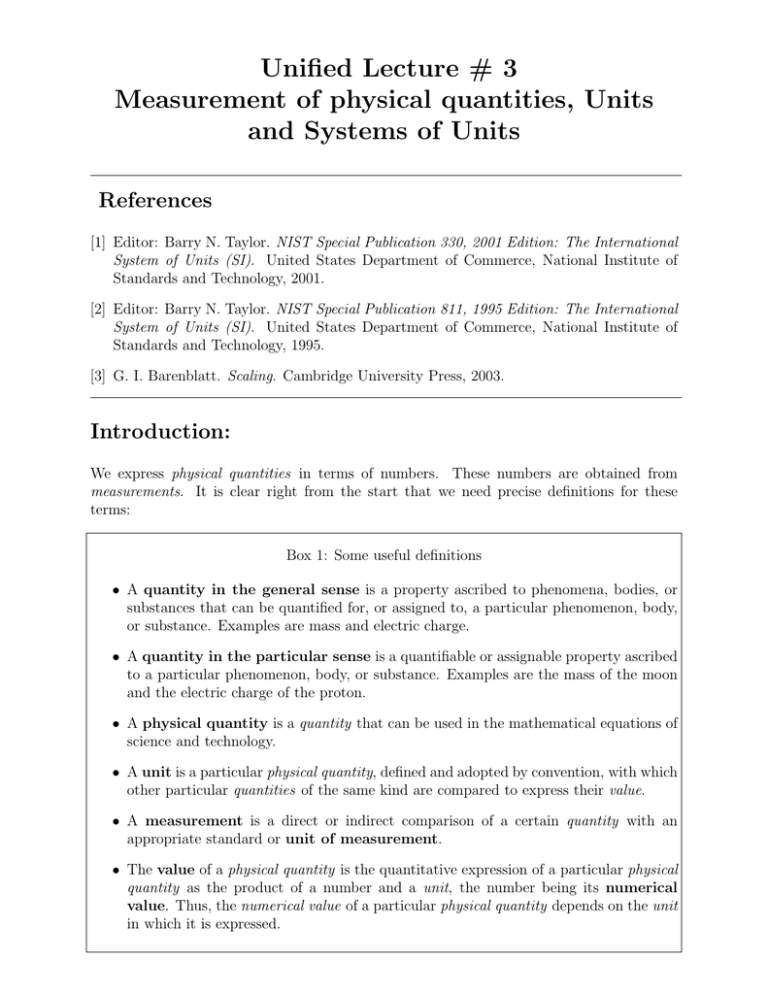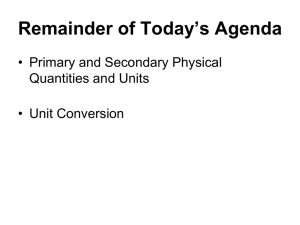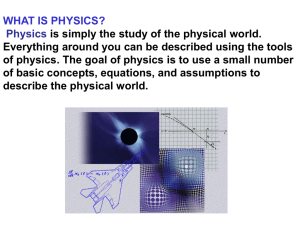Unified Lecture # 3 Measurement of physical quantities, Units
advertisement

Unified Lecture # 3
Measurement of physical quantities, Units
and Systems of Units
References
[1] Editor: Barry N. Taylor. NIST Special Publication 330, 2001 Edition: The International
System of Units (SI). United States Department of Commerce, National Institute of
Standards and Technology, 2001.
[2] Editor: Barry N. Taylor. NIST Special Publication 811, 1995 Edition: The International
System of Units (SI). United States Department of Commerce, National Institute of
Standards and Technology, 1995.
[3] G. I. Barenblatt. Scaling. Cambridge University Press, 2003.
Introduction:
We express physical quantities in terms of numbers. These numbers are obtained from
measurements. It is clear right from the start that we need precise definitions for these
terms:
Box 1: Some useful definitions
• A quantity in the general sense is a property ascribed to phenomena, bodies, or
substances that can be quantified for, or assigned to, a particular phenomenon, body,
or substance. Examples are mass and electric charge.
• A quantity in the particular sense is a quantifiable or assignable property ascribed
to a particular phenomenon, body, or substance. Examples are the mass of the moon
and the electric charge of the proton.
• A physical quantity is a quantity that can be used in the mathematical equations of
science and technology.
• A unit is a particular physical quantity, defined and adopted by convention, with which
other particular quantities of the same kind are compared to express their value.
• A measurement is a direct or indirect comparison of a certain quantity with an
appropriate standard or unit of measurement.
• The value of a physical quantity is the quantitative expression of a particular physical
quantity as the product of a number and a unit, the number being its numerical
value. Thus, the numerical value of a particular physical quantity depends on the unit
in which it is expressed.
Example:
The value of the height hW of the Washington Monument is hW = 169m = 555f t. Here hW
is the physical quantity, its value expressed in the unit ”meter,” unit symbol m, is 169m, and
its numerical value when expressed in meters is 169. However, the value of hW expressed in
the unit ”foot,” symbol ft, is 555f t, and its numerical value when expressed in feet is 555:
hW
|{z}
=
value of the physical quantity
169
m
|{z}
|{z}
value unit
|numerical {z
}
value
Fundamental and derived units
We said we need units to measure physical quantities. This process usually goes as follows:
1. Single out (Identify) the class of phenomena of interest (mechanics, electromagnetics,
etc)
2. List physical quantities involved.
3. Adopt standard reference values for fundamental quantities. Realize that mathematical expressions relate these quantities, therefore they cannot all have independent
reference standards.
4. Once fundamental units have been decided upon, derived units are obtained from the
fundamental units using the mathematical definitions relating the quantities involved.
Example
1. Phenomenon: Geometry of objects
2. Physical quantities: Length
3. Fundamental units: meter (symbol m).
4. Derived units:
• Area: meter squared (symbol m2 )
• Volume: meter squared (symbol m3 )
Here are some other examples to think about:
Example
1. Phenomenon: kinematics of bodies
2. Physical quantities: Length, Time, Velocity, Acceleration
3. Fundamental units:
• Length: meter (symbol m)
• Time: second (symbol s or sometimes sec).
4. Derived units:
• Velocity: meter per second (symbol m/s or m/sec)
• Acceleration: meter per second squared (symbol m/s or m/sec2 )
Example
1. Phenomenon: Kinetics or Dynamics of bodies
2. Physical quantities:
3. Fundamental units:
•
•
• ...
4. Derived units:
•
•
• ...
We observe from these examples that it is the class of phenomena under consideration, i.e.,
the complete set of physical quantities in which we are interested that ultimately determines
if a given set of fundamental units is sufficient for its measurement. For example, it is not
possible to define a unit of density from the fundamental units of length and time. It is
necessary to add the unit of mass.
System of units:
A set of fundamental units that is sufficient for measuring the properties of the class of
phenomena under consideration is called a system of units.
The International System of Units
The official U.S. website with information on the SI is the Physics Laboratory of NIST.
You may download the authoritative publications for future reference directly from these
links:
• NIST Special Publication 811. Guide for the Use of the International System of Units
(SI)
• NIST Special Publication 330. The International System of Units (SI)
The International System of Units, universally abbreviated SI (from the French Le Système
International d’Unités ), is the modern metric system of measurement. Long the dominant
system used in science, the SI is rapidly becoming the dominant measurement system used
in international commerce. In recognition of this fact and the increasing global nature of the
marketplace, the Omnibus Trade and Competitiveness Act of 1988, which changed
the name of the National Bureau of Standards (NBS) to the National Institute of Standards
and Technology (NIST) and gave to NIST the added task of helping U.S. industry increase its competitiveness, designates the metric system of measurement as the
preferred system of weights and measures for United States trade and commerce.
The definitive international reference on the SI is a booklet published by the International
Bureau of Weights and Measures (BIPM, Bureau International des Poids et Mesures).
SI base units
The SI is founded on seven SI base units for seven base quantities assumed to be mutually
independent:
SI base units
Name
Symbol
SI base unit
length
meter
m
mass
kilogram kg
time
second
s
electric current
ampere
A
thermodynamic temperature kelvin
K
amount of substance
mole
mol
luminous intensity
candela
cd
Base quantity
Definitions of the SI base units
Unit of length
meter
The meter is the length of the path travelled by
light in vacuum during a time interval of 1/299
792 458 of a second.
Unit of mass
kilogram The kilogram is the unit of mass; it is equal to
the mass of the international prototype of the
kilogram.
Unit of time
second
The second is the duration of 9 192 631 770 periods of the radiation corresponding to the transition between the two hyperfine levels of the
ground state of the cesium 133 atom.
Unit of electric current
ampere
The ampere is that constant current which, if
maintained in two straight parallel conductors
of infinite length, of negligible circular crosssection, and placed 1 meter apart in vacuum,
would produce between these conductors a force
equal to 2 x 10-7 newton per meter of length.
Unit of thermodynamic tem- kelvin
The kelvin, unit of thermodynamic temperature,
perature
is the fraction 1/273.16 of the thermodynamic
temperature of the triple point of water.
Unit of amount of substance mole
1. The mole is the amount of substance of a system which contains as many elementary entities
as there are atoms in 0.012 kilogram of carbon
12; its symbol is ”mol.”
2. When the mole is used, the elementary
entities must be specified and may be atoms,
molecules, ions, electrons, other particles, or
specified groups of such particles.
Unit of luminous intensity
candela
The candela is the luminous intensity, in a given
direction, of a source that emits monochromatic
radiation of frequency 540 x 1012 hertz and that
has a radiant intensity in that direction of 1/683
watt per steradian.
SI derived units
Other quantities, called derived quantities, are defined in terms of the seven base quantities
via a system of quantity equations. The SI derived units for these derived quantities
are obtained from these equations and the seven SI base units.
Examples of SI derived units
SI derived unit
Derived quantity Name
area
square meter
volume
cubic meter
speed, velocity
meter per second
acceleration
meter per second squared
mass density
kilogram per cubic meter
specific volume
cubic meter per kilogram
current density
ampere per square meter
Symbol
m2
m3
m/s
m/s2
kg/m3
m3 /kg
A/m
For ease of understanding and convenience, 22 SI derived units have been given special names
and symbols
22 SI derived units with special names and symbols
SI derived unit
Derived quantity
Name
Symbol Expression in Expression in
terms of other terms of SI
SI units
base units
plane angle
radian
rad
m · m−1 = 1
solid angle
steradian
sr
m2 · m−2 = 1
frequency
hertz
Hz
s−1
force
newton
N
m · kg · s−2
2
pressure, stress
pascal
Pa
N/m
m−1 · kg · s−2
energy, work, quantity of joule
J
N ·m
m2 · kg · s−2
heat
power, radiant flux
watt
W
J/s
m2 · kg · s−3
electric charge, quantity of coulomb
C
s·A
electricity
electric potential difference, volt
V
W/A
m2 · kg · s−3 · A−1
electromotive force
capacitance
farad
F
C/V
m−2 · kg −1 · s4 · A2
electric resistance
ohm
Ω
V /A
m2 · kg · s−3 · A
electric conductance
siemens
S
A/V
m−2 · kg −1 · s3 · A2
magnetic flux
weber
Wb
V ·s
m2 · kg · s−2 · A−1
magnetic flux density
tesla
T
W b/m2
kg · s−2 · A−1
inductance
henry
H
W b/A
m2 · kg · s−2 · A−2
Celsius temperature
degree Celsius o C
K
luminous flux
lumen
lm
cd · sr
m2 · m−2 · cd = cd
illuminance
lux
lx
lm/m2
m2 · m−4 · cd =
m−2 · cd
activity (of a radionuclide)
becquerel
Bq
s−1
absorbed dose, specific en- gray
Gy
J/kg
m2 · s−2
ergy (imparted), kerma
dose equivalent
sievert
Sv
J/kg
m2 · s−2
catalytic activity
katal
kat
s − 1 · mol
Relationships of the SI derived units with special names and symbols and the SI
base units
The diagram above shows graphically how the 22 SI derived units with special names and
symbols are related to the seven SI base units. In the first column the symbols of the SI
base units are shown in rectangles, with the name of the unit shown toward the upper left
of the rectangle and the name of the associated base quantity shown in italic type below the
rectangle. In the third column the symbols of the derived units with special names are shown
in solid circles, with the name of the unit shown toward the upper left of the circle, the name
of the associated derived quantity shown in italic type below the circle, and an expression
for the derived unit in terms of other units shown toward the upper right in parenthesis. In
the second column are shown those derived units without special names [the cubic meter
(m3 ) excepted] that are used in the derivation of the derived units with special names. In
the diagram the derivation of each derived unit is indicated by arrows that bring in units in
the numerator (solid lines) and units in the denominator (broken lines), as appropriate.
SI prefixes
The 20 SI prefixes used to form decimal multiples and submultiples of SI units are
Factor
1024
1021
1018
1015
1012
109
106
103
102
101
Name
yotta
zetta
exa
peta
tera
giga
mega
kilo
hecto
deka
SI prefixes
Symbol Factor
10−1
Y
Z
10−2
10−3
E
P
10−6
10−9
T
10−12
G
M
10−15
10−18
k
h
10−21
da
10−24
Name
deci
centi
milli
micro
nano
pico
femto
atto
zepto
yocto
Symbol
d
c
m
µ
n
p
f
a
z
y
Units outside the SI
Certain units are not part of the International System of Units, that is, they are outside the
SI, but are important and widely used. Examples are:
• the minute (time), symbol: min, value in SI units: 1min = 60s
• the hour (time), symbol: hr, value in SI units: 1hr = 3600s
• units of angle: degree, minute, second
• the liter
• the electronvolt
• the hectare
• the Angstrom
• etc
Classes of systems of units
Two systems of units are said to be in the same class of systems of units if both systems
use standard quantities of the same physical nature as fundamental units. For example,
for mechanics phenomena, the SI uses length, mass and time as the standard quantities
defining the fundamental units. We denote this class of system of units as the LM T
class. The fundamental units are the meter, the Kilogram and the second. Any system of
units that uses the same standard quantities will be in the same class. The CGS system is
in the same class as the SI but the fundamental units are the centimeter, the gram and the
second.
Dimensions
The relation that describes a derived unit for a certain quantity in terms of the fundamental
units is called the dimension. It is customary (following a suggestion of Maxwell) to denote
the dimension of a quantity q by [q]. For example, the dimension of density ρ in the LM T
class is:
[ρ] = M L−3
Dimensional and dimensionless quantities Quantities whose numerical values are
identical in all systems of units within a given class are called dimensionless. All other
quantities are called dimensional.
Dimensional consistency of equations The dimensions of both sides of any equation with physical sense must be identical. Otherwise, an equality in one system would
be broken upon conversion to another system.
This fact is used to obtain derived units from fundamental units.
Example
In the LM T class, the dimension of mass is M , the dimension of acceleration is LT −2 , the
dimension of force can be obtained (derived) from Newton’s second law:
f = ma
[f ] = [m] [a] = M LT −2
In other words, in the LM T class, the dimension of force is LM T −2 .
We can determine the unknown exponent “?” in the following equation by requiring the
same units on both sides:
E = m c?
?
ML2 T−2 = M LT−1
→ ? = 2
This is one technique of Dimensional Analysis, which can allow us to identify the controlling
physical quantities in unfamiliar or complicated quantities.
Fluid Dynamics, Solid Mechanics and Thermodynamics make extensive use of dimensional
analysis.
Some conversion factors between SI and English systems
dimension
SI unit English Unit
conversion
Length
Time
Mass
Force
Pressure
m
s
Kg
N
Pa
0.305 m/ft
—
14.6 Kg/slug
4.45 N/lb
6900 Pa/psi
ft
sec
slug
lb
psi
In the SI system, mass (Kg) is a fundamental unit, and force (N) is the derived unit, while
In the English system, force (lb) is a fundamental unit, and mass (slug) is derived. This
distinction is not too important in practice.
Final recommendations regarding Units and Dimensions
• Be VERY careful to give units with any numerical quantity.
• Be VERY careful not to mix units — “cannot combine or compare apples & oranges”
• Use dimensions as a check on equation correctness.




